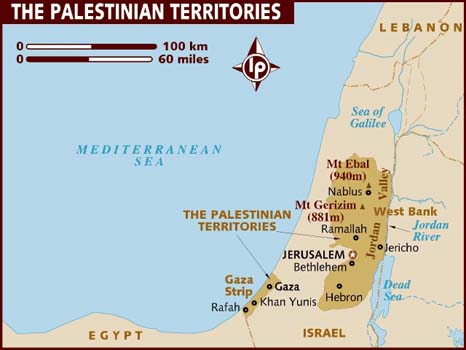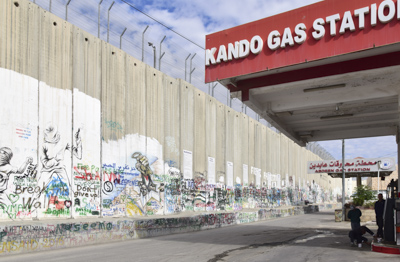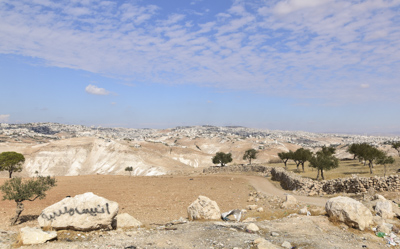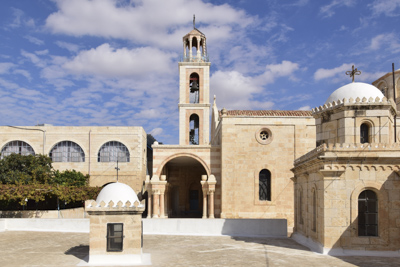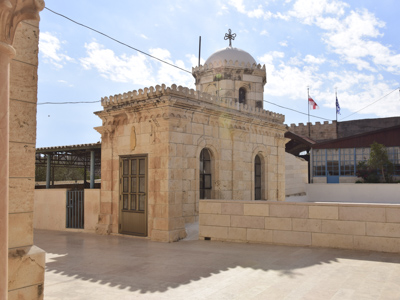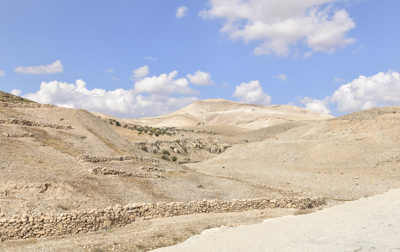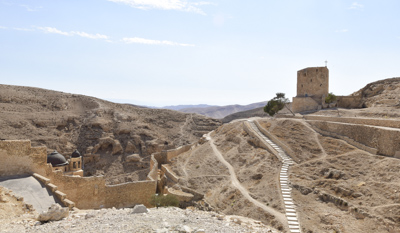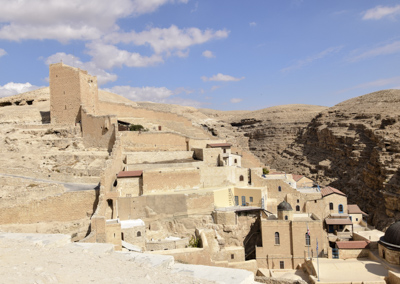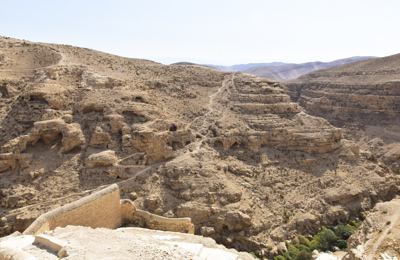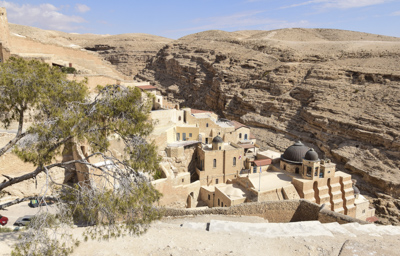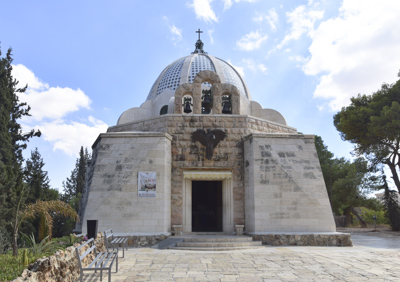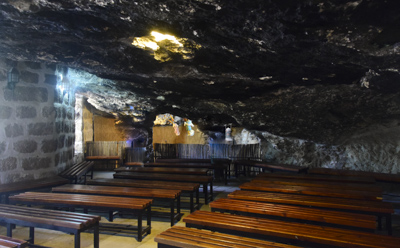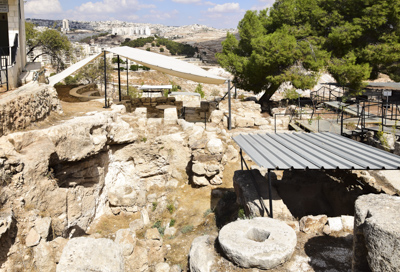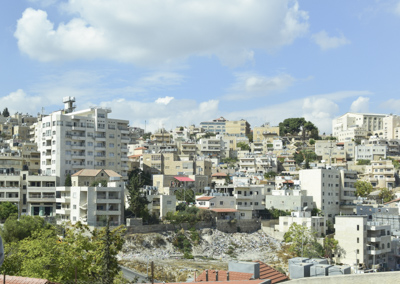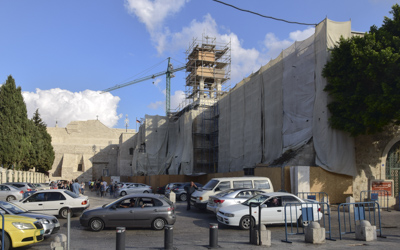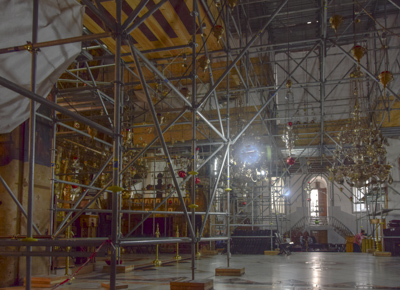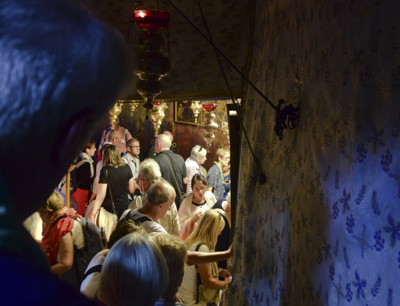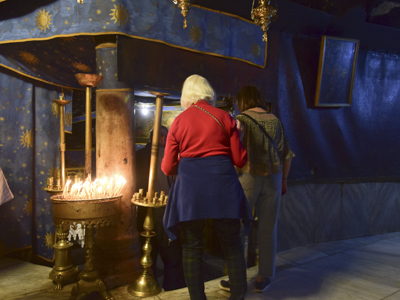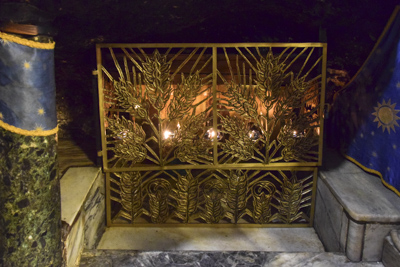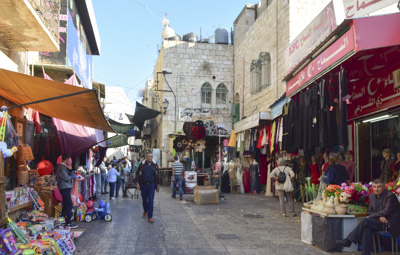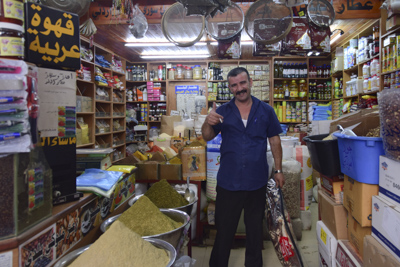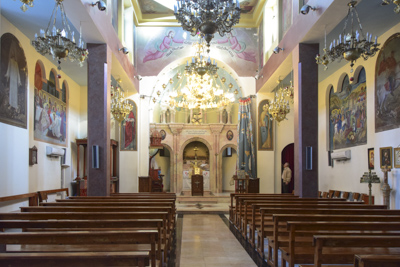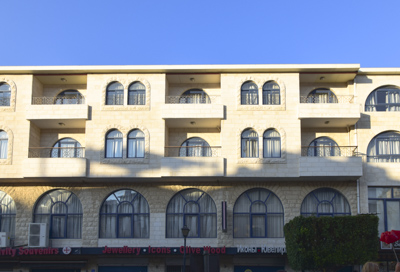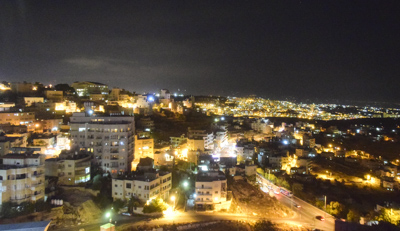Monday – October 16, 2017
I enjoyed another good breakfast at the Cinema Hotel in Tel Aviv, Israel before gathering in the lobby with four other intrepid travelers. Today was the beginning of a 5-day extension to the OAT Israel Tour which ended yesterday. Five of us would continue to travel through the Palestinian Territory also known as the “West Bank.” I had mixed feelings: excitement to explore a new destination but concerns about safety and unrest in the region.
Rafi Rozanes, our Israeli tour guide, was there early to help us board a new bus and get us going on another adventure. Thank you Rafi! We drove from Tel Aviv to the town of Beit Jala, near Bethlehem in the West Bank. On the side of a dusty road, we switched buses and met our Palestinian tour guide, Hisham Ikhmayes.
Very soon, we were introduced to one of the contentious issues between the Palestinians and Israelis. This was the “Israeli West Bank Barrier” aka “The Wall” aka “Security Fence” aka “Apartheid Wall.” The wall was begun in September 2000 by the Israeli government as a temporary security measure at a time of heightened tensions. It is now seen as a future political border between Israel and Palestine.
75% of the population of Beit Jala is Christian, mostly Greek Orthodox, and about 25% of the people are Muslim.
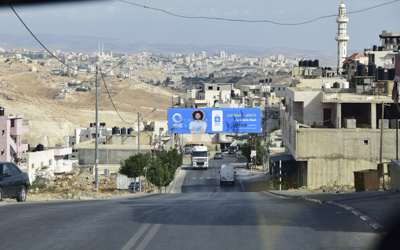
The photo below shows the landscape around Beit Jala – the city of Jerusalem is in the distance. We were only 10 kms (6 miles) away from the “Holy City”.
Our bus stopped in front of the Greek Orthodox Monastery of St. Theodosius. Hisham had noticed traffic in front of the building and told us that the monastery was rarely open for tourists. He said we were lucky as we walked through the gates and entered the grounds of the monastery with a group of Greek pilgrims.
The Monastery of St. Theodosius was founded in 476 by Theodosius the Cenobiarch and contains his tomb. A cave on the monastery grounds is supposed to be the place where the three Magi took shelter during the night after delivering gifts to the newborn baby Jesus. Access to the cave is inside the small building pictured below.
We watched as an old woman dressed in black passed keys to an elderly monk in front of the building. He opened the bronze doors and allowed the Greek tourists to enter and climb down the stairs.
We followed them down and entered the cave. The walls were covered with stucco and filled with icons and paintings of saints. There was a small altar on one side. The pilgrims lined up and took turns to touch, kiss the icons, and pray. We were indeed lucky to witness this amazing sight.
We left quietly and continued along the road through the desert to Mar Saba Monastery in the Kidron Valley.
The monastery of Saint Sabba was founded in 483 AD and is an Eastern Orthodox Christian monastery. Today the complex houses less than 20 monks and is considered to be one of the oldest inhabited monasteries in the world.
The facility still maintains many of its ancient traditions including the restriction of women from entering the compound. The only building women can enter is the Women’s Tower, high on a hill away from the monastery. It’s the building on the left in the photo above.
It is believed that this monastery will host the last Divine Liturgy on earth before the second coming of Christ.
We walked to the Women’s Tower and climbed up the stairs to have a better view of the monastery.
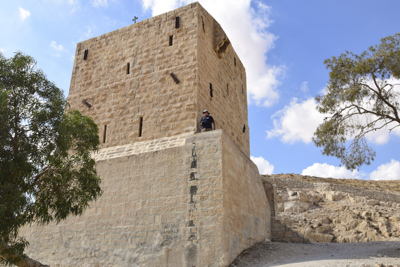

We drove back toward Bethlehem and stopped at Shepherd’s Field. This is the place where the angels first announced the birth of Christ. There are two sites near each other, which are claimed by different Christian denominations to be the actual “Shepherds’ Field.” One belongs to the Greek Orthodox Church and the other to the Catholic Franciscan Order.
We went to the Catholic Chapel of the Shepherd’s Field whose history dates back to the 5th century. The present chapel was built near the ruins of an ancient monastery in 1953. Under the chapel there was a large cave which we also explored.
Adjacent to this site were the excavations of a 4th – 6th century Byzantine church and monastery. We walked past and snapped a few photos. It seems that everyone wants a piece of the “tourist pie.”
Afterwards, we had a delicious shawarma-in-pita-bread lunch at a restaurant nearby and then continued on to the city of Bethlehem.
As luck would have it, the UNESCO World Heritage Site of The Church of the Nativity was under major reconstruction and completely covered (inside and outside) with scaffolding and canvas.
Of course, this did not deter the huge crowds of tourists who traveled thousands of miles and waited in long lines in the sanctuary to finally gain entry into the very small cave under the church and crawl under the altar to touch or kiss the silver star that marks the birth site. Two million visitors go to Bethlehem every year!
It was single file down a stairway and through a short narrow portal in order to gain entry into the Grotto of the Nativity. Underneath an altar there was a 14-point silver star mounted in marble which supposedly marked the birthplace.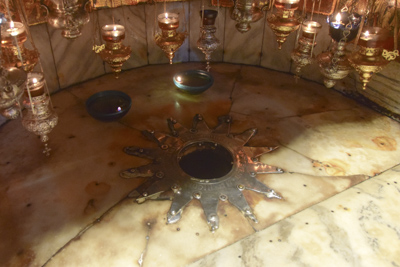
Across the “cave” was another small area which is the “Grotto of the Manger.”
The Church of the Nativity is a complex of churches and chapels administered jointly by several Christian denominations: Armenian Apostolic, Greek Orthodox, Roman Catholic, and Syriac Orthodox.
The Church of Saint Catherine is adjacent to the Church of the Nativity and they were holding a mass when we looked in. We left the churches and crossed the plaza and entered 21st century Bethlehem! That’s The Mosque of Omar in the photo below. It is the oldest and only mosque in the old city of Bethlehem.
We walked into a narrow alleyway and I felt immediately comfortable in the medieval middle-eastern city. It reminded me of the back streets in Turkey.
We were on our way back to the Manger Square Hotel and we passed an interesting building on a steep hill.
This was the Church of the Mother of God, Syrian Orthodox Church. Many Syriac Orthodox families had migrated to Palestine and settled in Bethlehem as a result of the genocide in 1915 by the Ottoman Turks. The Syrian Christian community built the church between 1922-1928.
We were lucky again because the caretaker of the church was standing outside. Hisham spoke to him and he opened the door and led us into the beautiful sanctuary. The caretaker very proudly showed us the ancient illuminated bible in front of the altar. The Syrian Orthodox Church traces its roots to one of the oldest communities of Antioch and was established as a congregation by the Apostle Peter in 37 AD.
The Manger Square Hotel was a short walk away. We checked in and found our assigned rooms. Dinner was in a large dining room with many tables set up and reserved for groups with religious affiliations: “Mother Fatima’s Group,” “Evangelical Pilgrims Group,” “Faith Ministry Group,” etc. etc. We ate an interesting self-serve dinner of bright-green soup, lamb stew, rice with peas and beans. The soup was a Middle-Eastern favorite and comfort-food and made from a plant called molokhia or mulukhiyah, also called Jew’s mallow or jute. It was delicious.
Below are two views of Bethlehem from my room window. It had been another incredible day!
